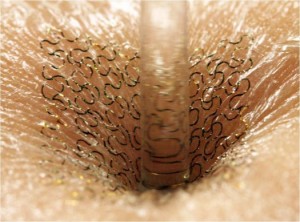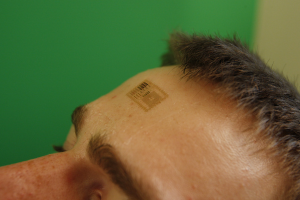Combining body and machine. Science fiction? Maybe not.
Researchers led by John Rogers from the University of Illinois at Urbana-Champaign have developed the world’s first flexible, stretchable, and skin-like monitor, which is capable of attaching to the epidermis of the skin by a process similar to applying a temporary tattoo. This wireless device can accurately collect data from the human body for up to 6 hours without irritating the skin.
Inspired by the concept of telephone cords, this device features a netted S-shaped circuitry that can be greatly deformed without disturbing the function of the monitor. To make them even more durable, both sides are covered with protective layers of a polymer called polyimide. The device can be hidden under a tattoo to help it be concealed and remain attached longer. At the moment, long term use is limited because of surface skin cells sloughing off periodically.
In its current form, the device would be most applicable in the medical field because of its ability to be seamlessly integrated into the skin of patients to monitor their activity constantly. By placing them in different locations on the body, medical staff could collect different electrical signals from the body such as brain waves, heart beats and skeletal muscle activity. This new technology is especially useful for premature babies because it could monitor their progress without any bulky electronics irritating their fragile skin.
Aside from the medical community, security groups and intelligence agencies such as the CIA are also developing an interest in this technology; slight changes to this technology could enable agents to communicate silently with a patch hidden on their throats. This kind of patch would sense muscle movements in the throat and silently transmit the messages via wireless waves. With the initial prototype developed by Dr. Rogers’ team, many changes can be made to this technology to create a virtually infinite number of adaptations in the future.
Watch the Youtube video describing the epidermal electronic below:
http://youtu.be/fl1VS_kONlQ



October 10th, 2011 at 3:48 pm
This is really cool! I never thought this could be possible. But at same time this is scary because this can turn into many different fields that could be potentially very dangerous.
October 12th, 2011 at 1:31 pm
I initially thought this sounded extremely creepy. However, I think the potential medical uses could really save lives. I almost wonder if one day, we would all be implanted with a permanent version from birth and it would monitor all our vitals. We could already be at the hospital before the heart attack even occurs!
October 14th, 2011 at 2:47 pm
Now I know what I’m going to get for my next tattoo!
October 14th, 2011 at 6:49 pm
This is amazing. I envisioned things like this as a kid, but never thought it would come to reality. I do suspect however, that this technology may extend beyond medical applications. Perhaps even be misused.
This technology is sure to evolve and become more complex. I can’t help but remember one of the video games I used to play. In it the main character is an elite soldier who has ‘nano-machines’ injected in his blood stream that help monitor his vital body conditions and help keep them in balance.
October 14th, 2011 at 10:46 pm
I recently watched the first episode of a new Nature of Things series about nanotechnology that talked about something very similar. This is really interesting — but what do you think? Would the benefits outweigh the potential privacy issues?
October 15th, 2011 at 11:40 pm
Since these come off every few weeks, it’s going to be painful to put it back on every time it comes off. Also, wouldn’t there be a security breach if it falls off and someone comes and picks it up?
October 17th, 2011 at 7:42 pm
If they can find a way to make these longer lasting which I assume they must be looking into (maybe by making internal ones to avoid the problem of the device coming off with skin cells periodically), then the possibilties would be endless. Like Christina says, if they pick up an irregular heartbeat you may be able to get help before you have a heart attack. Or maybe they could create devices that detect cancer cells or bacteria/viruses in the blood and therefore allow for quicker treatment which would save thousands of lives.